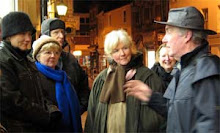
One of many Green Man representations.
If you look carefully in many churches and cathedrals throughout Britain and Europe, there is every chance that you may stumble across a Green Man or two somewhere amongst the corbels and pews. Whether you discover him chiselled in stone or carved in wood or rendered in stained-glass, his purpose in the grand scheme of things still eludes scholars to this day, not helped I’m sure, by his ever changing image. Over the centuries, carvings and sculptures have change dramatically, from the outright grotesque to an enigmatic figure sprouting foliage from every orifice. So with little to go on, except for folklore, the question remains, do we revere or fear the Green Man?
A brief history of the Green Man can trace his image back to ancient Rome, were some of the crudest of sculptures can be found.
He appears in a 14th century poem taken from Arthurian legend where he disguises himself as the Green Knight, and tricks Sir Gawain of Camelot into a wager whereby Sir Gawain is given the chance to chop off the Green Knight’s head. If Sir Gawain should be successful then the Green Knight would surely die, but if by chance Sir Gawain be unsuccessful and the Green Knight should live, then the Green Knight shall arrange a place for both to meet in precisely one years time, whereupon the Green Knight will remove Sir Gawain's head. Without further ado, Sir Gawain accepts the challenge and lobs off the Green Knights head but to his astonishment the headless knight retrieves his head and places it back on his shoulders. The challenge is set and Sir Gawain, with honour intact, awaits his rendezvous and certain doom with the Green Knight in one years time.
In ancient Celtic mythology, the Green Man was perceived as the god of spring and summer, bringing life and resurrection to the forests and woodland, only to take life away for the coming of winter.
In pre-Christian times it was widely believed that the forests and woodlands were the domain of nature spirits, these beliefs may have inspired the Green Man myth. Primitive beliefs I grant you, but if you look a little deeper this philosophy is not as far fetched as would first appear. Consider for a moment mother earth as a living, breathing, changing entity, by ‘changing’ I refer to her seasons. She provides us with all the essentials to sustain life. It is therefore not so difficult to see why our pagan ancestors should adopt a spirit entity to give thanks for these gifts of life, after all, established religion asks us to have belief without evidence and to put our faith in a supernatural being?
I believe the Green Man should be revered as a symbol of new life and all that is good in nature, perhaps this belief in new birth and its Christian applications has allowed the Green Man some status in our churches, it wasn’t too long ago that his association with the pagan culture nearly eradicated his image from churches and cathedrals altogether.
So the next time you are strolling through a wood, and the sun breaks through the canopy above you, bathing the woodland floor in a shimmering mist of gold. Just take a moment of your time to pause and take in the beauty of mother nature. I’m sure it won’t be too long before you too see the Green Man in all his splendour.






No comments:
Post a Comment